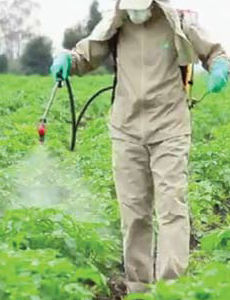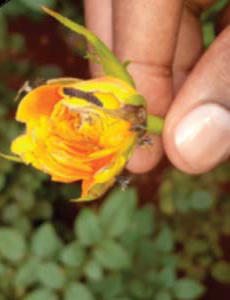 Pesticide resistance can become a problem when the same chemicals are used over and over to control a particular pest. After a period, the pest may develop resistance to a chemical so that the chemical no longer effectively controls the pest at the same rate, and higher rates and more frequent applications become necessary until eventually the chemical provides little or no control.
Pesticide resistance can become a problem when the same chemicals are used over and over to control a particular pest. After a period, the pest may develop resistance to a chemical so that the chemical no longer effectively controls the pest at the same rate, and higher rates and more frequent applications become necessary until eventually the chemical provides little or no control.
The best way to manage pesticide resistance is to focus on three strategies: avoid, delay, and reversal. Avoid the development of pesticide resistance problems with the use of Integrated Pest Management (IPM) programs, which reduce reliance on chemical control. Delay resistance by using pesticides only when needed, as indicated by monitoring, and when pests are at a susceptible stage.
Delay can also be achieved by using pesticides from different chemical classes (e.g., organophosphates, carbamates, pyrethroids, biologicals, etc.) and rotating their use. Reversal of some resistance can occur by allowing time between applications of a class of pesticide to permit resistant populations to become diluted by pesticide-susceptible individuals. Key elements of resistance management include minimizing pesticide use, avoiding tank mixes, avoiding persistent chemicals, and using long-term rotations of pesticide from different chemical classes.
Minimize Pesticide Use
Minimizing pesticide use is fundamental to pesticide resistance management. IPM programs incorporating pest monitoring have demonstrated 25 to 50% reduction in pesticide use with an increase in crop quality. Ask your IPM Consultant for information on setting up and maintaining an IPM monitoring program. Such a program will help determine the best application timing for pesticides (when they will do the most good), thus helping to reduce the number of applications.
The use of nonchemical strategies, such as pest exclusion (e.g., screening), host-free periods, crop rotation, biological control, and weed control may reduce the need to use chemicals and consequently slow the development of pesticide resistance.
Avoid Tank Mixes
Avoid combinations (mixes) of two insecticides or miticides in a single application. Especially avoid mixing two insecticides with the same mode of action, such as the organophosphates, acephate and malathion; this increases selection for resistant pests. Such a ‘super dose’ often increases the chances of selection for resistant individuals.
In some cases, mixing pesticides from two different classes provides superior control. However, longterm use of these two-class pesticide mixes can also give rise to pesticide resistance, if resistance mechanisms to both pesticides arise together in some individuals. Continued use of the mixture will select for these multiple-pesticide-resistant pests.
In specific situations the simultaneous application of two different types of chemicals may be necessary, but even in these cases tank mixes should be avoided. For example, insect growth regulators (IGRs) only control the immature stages of insects. If the adult stage must also be controlled, it will be necessary to apply another insecticide. Rather than applying an adulticide in the same manner as the IGR, however, choose a formulation that requires a different type of application. For instance, if the IGR is applied as a spray, it would be preferable for the adulticide to be applied as an aerosol or smoke with rapid kill of the adults and little residual that might select for resistance buildup in surviving immatures.
 Avoid Persistent Chemicals.
Avoid Persistent Chemicals.
Insects with resistant genes will be selected over susceptible ones whenever insecticide concentrations kill only the susceptible pests. An ideal pesticide quickly disappears from the environment so that persistence of a ‘selecting dose’ does not occur. When persistent chemicals must be used, consider where they can be used in a rotation scheme to provide the control needed and with a minimum length of exposure. One example of a persistent material that must be carefully timed to avoid prolonged exposure is the use of imidacloprid for control of whiteflies.
Application of this material early in the crop prolongs the exposure of the whitefly population to this material. It may be best to use natural enemies and/or insect growth regulators early in the crop followed by imidacloprid, if needed. Applications that are too late do not allow the plant to absorb the material to provide effective control. The best time to apply this material is not later than 3 weeks before poinsettia color initiation.
Use Long-term Rotations.
Resistance management strategies for insects, weeds, and fungal pathogens all include rotating classes of pesticides (e.g., pesticides with the same mode of action such as pyrethroids, organophosphates, carbamates, etc.). Pesticides with the same modes of action have been assigned the same group number by their respective pesticide resistance action committees (IRAC [Insecticide Resistance Action Committee], FRAC [Fungicide Resistance Action Committee], and HRAC [Herbicide Resistance Action Committee].
These group numbers have been included in the treatment tables of this guideline to help clarify when rotating pesticides, which ones can be rotated. However, the strategies used in rotations differ. For example, with fungicides, it is suggested that classes be rotated every application. With insecticides, a single chemical class should be used for a single generation of the target pest followed by a rotation to a new class of insecticide that will affect the next generation and any survivors from the first generation. Longer use of a single chemical class will enhance the chance of resistance since the survivors of the first generation and the next will most likely be tolerant to that class. Rotating through many chemical classes in successive generations will help maintain efficacy.
If there is only one chemical that is effective against a pest and other available products are only marginally effective, a good strategy to follow is to use the marginally effective materials at times when pest pressure is less severe and to reserve the effective material for those periods of time when control must be most effective.
